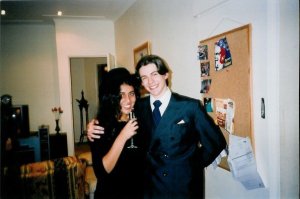47. The Satanic Verses (Salman Rushdie)
“I want to be Salman Rushdie’s fifth wife”. So proclaimed fellow student Toby as we discussed our favourite writers in one of our early English Honours classes. (The rest of us gently explained that as far we knew, Rushdie wasn’t that way inclined but I don’t think Toby was deterred) At the time, I wasn’t sure that I agreed with him. Rushdie is prickly, and his books take a sort of stamina which I didn’t have at 21. Indeed, it was only partway through a borrowed The Satanic Verses last week that I realised that I had attempted to read it before…and in fact already had a copy of it at my parents’ house. Awkward. I think that when I first attempted it, the biggest surprise around the book’s controversy was that anyone could have first gotten around to finishing the dense, magical realist novel. Then again, I suppose that issuing a fatwa doesn’t necessarily require finishing the book. As with so many other censored books and films, much of the outrage was – and continues to be – largely fuelled by hearsay.
I have since been converted though (no pun intended!) and now think that Rushdie is a genius. By the way – his self-important writing style would suggest that he knows the same. Yet I would still hesitate to say that The Satanic Verses has been my favourite book this year (and certainly believe that it should have ceded the 1989 Booker Prize to the wonderful Oscar and Lucinda). Almost par for the course for a Rushdie novel, The Satanic Verses weaves together stories of history, migration and the (hazy) power of the word. It is also full of magic – but Rushdie limits his reliance on magic to that which is necessary for his purposes. Yes, Gibreel Farishta and Saladin Chamcha fall from a seemingly unsurvivable plane crash and go on to represent, respectively, the Angel Gabriel and Satan in their adopted home of London, but this is part of a wider representation of good and evil and how the two concepts interchange. Gibreel is a celebrated star of Indian cinema, who has played gods so frequently in so-called “theologicals” (such an Indian term) that he is almost seen as one himself. Chamcha is an actor who has emigrated from smoggy Bombay to foggy London, to become a largely unrecognised voice actor. Gibreel is the obvious choice of born-again Angel while Chamcha is mortified to discover that he is developing goat’s horns and hooves after his fall from grace. In reality, Gibreel’s jealousy (exhaustively equated by Rushdie to that of Othello) is a little like the halitosis that he never fully manages to hide and ends up transforming him into Azraeel, the angel of death, as his radiance intensifies to consuming fire.
Throughout the novel, Rushdie ponders: “How does newness come into the world? How is it born?” More and more, the answer seems to be through migration. Rushdie tries his hand at so many stories in this novel, but all of them center on some type of journey. Each is expertly done. My favourite modern-day story was that of Alleluia Cone, Gibreel’s lover/famous mountaineer who keeps a tiny ice replica of Everest in her freezer “brought out from time to time to show off to friends”. As Gibreel gains in strength, he seems to zap that of Allie’s – with Chamcha stepping in to help her achieve her (naturally) Desdemona-like end. Meanwhile, the Baphomet figure of Chamcha hides in the attic of the Shalmaar Cafe, which is agony for him because he’s spent years cultivating a genteel (read: Caucasian) Englishness and distancing himself from the ghastly sub-continent. Migration is never as simple as it seems, though. The riff-raff from whom Chamcha had tried to escape turn out to comprise – in part – two beautiful Bangladeshi-English girls who live in a “Bungleditch” cafe but would rather eat bangers and mash. Well, what else do you expect from a novel with Indian-English migrants that are – worse luck – also animal-human hybrids? Here, the ridiculous is normal. Yet, despite the surreal, the sentiments of the characters in Satanic Verses are rooted in basic and real human emotions. Migration is a dilemma, even if it doesn’t ordinarily manifest itself in the form of a “lionheaded goatbodied serpenttailed” man. Early in the text, Rushdie describes the important plane crash (well, when isn’t a plane crash an important plot point?!) as follows: “The aircraft cracked in half, a seed-pod giving up its spores, an egg yielding its mystery.” The particular beauty of that line left me gobsmacked for a while – and changed my enjoyment of my daily egg.
Other stories of migration are slightly more controversial, though. “The Satanic Verses” is another example of Rushdie’s way with titles, but he did have some help this time. The term refers to a set of pagan verses mistakenly included by Muhammad in the Qu’ran before he realised that they were the words of Satan. The verses themselves speak of three goddesses who rivalled Allah’s monotheism – and who, coincidentally, were the same goddesses worshipped by the Meccans who had otherwise persecuted Muhammad and his dogged band of followers. Rushdie weaves this already-compelling truth into a parallel narrative, in which an entrepreneurial Mahound recites and quickly retracts the verses, making him friends and enemies amongst his own crowd. In a recent article, Geoffrey Robertson QC – another husband contender – states that the “six blasphemies in the book” which were alleged against Rushdie during his trial for blasphemous libel (a crime abolished as a result of this case – law and literature unite!) were each “based either on a misreading or on theological error”. With respect, though, I’m not sure that the particularities which Robertson details are the ones which truly cause offence in the novel. Yes, “the book contains criticisms of the prophet Abraham for his conduct towards Hagar and Ismael, their son”. More importantly though, The Satanic Verses depicts a world in which people’s words/the Word are frequently wrong. When Rushdie’s Mahound claims that the verses were instigated by Satan, his relieved followers assume that it was part of his larger plan to expose them to the Devil’s workings and so enrich their faith. His response? “Yes…It was a wonderful thing I did. Deeper truth. Bringing you the Devil. Yes, that sounds like me.” In other words: sure, why not? In the same article as Robertson, a publisher at Penguin India at the time notes his surprise at learning that “there were passages in [the novel] that could be seized on by politicians and mullahs, taken out of context, and used to create mischief.” I find this astonishing – but then again there have been other plane crashes since The Satanic Verses and we might live in a slightly less innocent world.
In any event, Rushdie’s opponents should not feel too perturbed. The author uses this novel to express his own views as to the lush malleability of language. His writing is sublime but for those who don’t know Hindi, Bollywood/Kollywood cinema, Islam and Islamic history, and a smattering of Arabic it can be rather bewildering. Rushdie does not translate…there are no footnotes and no elaborate explanations. Perhaps he’d rather leave it to his audience, for fear that he too will misinterpret the “word(s)”. (I love his final acknowledgment – “the identities of many of the authors from whom I’ve learned will, I hope, be clear from the text” – Salman, we are not all as clever as you!). Sneakily, he even inserts an image of God into the novel, making it the second time this year I’ve imagined God as a young-ish, wry man – but here he is bearded. Who to believe?! There is much more to say but I might not say it right now – this novel was exhausting to read and writing this entry has proven much the same. Suffice to say, I am almost ready to join the same (surely long) queue as Toby, but hesitate slightly at Rushdie’s own words: “To meet a writer is, usually, to be disappointed.” Maybe that explains the disappearing wives?










